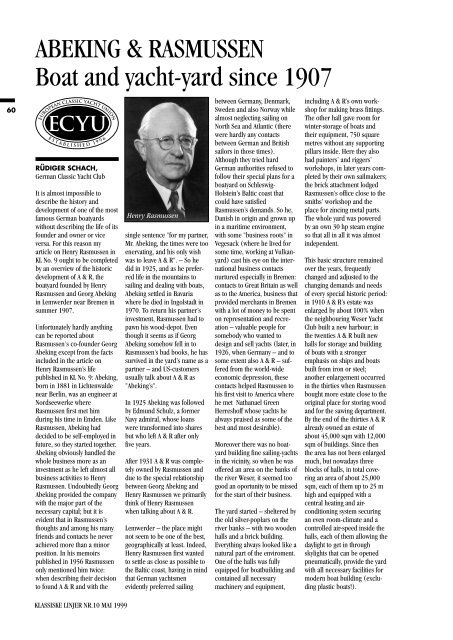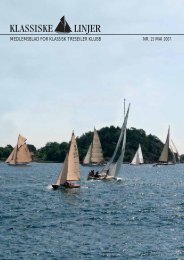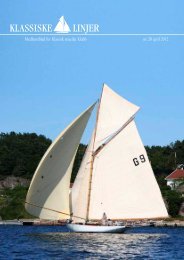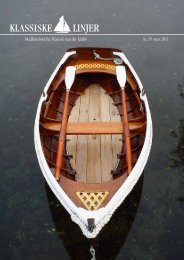Klassiske Linjer nr 10 1999 - Klassisk Treseiler Klubb
Klassiske Linjer nr 10 1999 - Klassisk Treseiler Klubb
Klassiske Linjer nr 10 1999 - Klassisk Treseiler Klubb
Create successful ePaper yourself
Turn your PDF publications into a flip-book with our unique Google optimized e-Paper software.
60<br />
ABEKING & RASMUSSEN<br />
Boat and yacht-yard since 1907<br />
RÜDIGER SCHACH,<br />
German Classic Yacht Club<br />
It is almost impossible to<br />
describe the history and<br />
development of one of the most<br />
famous German boatyards<br />
without describing the life of its<br />
founder and owner or vice<br />
versa. For this reason my<br />
article on He<strong>nr</strong>y Rasmussen in<br />
KL No. 9 ought to be completed<br />
by an overview of the historic<br />
development of A & R, the<br />
boatyard founded by He<strong>nr</strong>y<br />
Rasmussen and Georg Abeking<br />
in Lemwerder near Bremen in<br />
summer 1907.<br />
Unfortunately hardly anything<br />
can be reported about<br />
Rasmussen's co-founder Georg<br />
Abeking except from the facts<br />
included in the article on<br />
He<strong>nr</strong>y Rasmussen’s life<br />
published in KL No. 9: Abeking,<br />
born in 1881 in Lichtenwalde<br />
near Berlin, was an engineer at<br />
Nordseewerke where<br />
Rasmussen first met him<br />
during his time in Emden. Like<br />
Rasmussen, Abeking had<br />
decided to be self-employed in<br />
future, so they started together.<br />
Abeking obviously handled the<br />
whole business more as an<br />
investment as he left almost all<br />
business activities to He<strong>nr</strong>y<br />
Rasmussen. Undoubtedly Georg<br />
Abeking provided the company<br />
with the major part of the<br />
necessary capital; but it is<br />
evident that in Rasmussen’s<br />
thoughts and among his many<br />
friends and contacts he never<br />
achieved more than a minor<br />
position. In his memoirs<br />
published in 1956 Rasmussen<br />
only mentioned him twice:<br />
when describing their decision<br />
to found A & R and with the<br />
KLASSISKE LINJER NR.<strong>10</strong> MAI <strong>1999</strong><br />
He<strong>nr</strong>y Rasmussen<br />
single sentence "for my partner,<br />
Mr. Abeking, the times were too<br />
enervating, and his only wish<br />
was to leave A & R". – So he<br />
did in 1925, and as he preferred<br />
life in the mountains to<br />
sailing and dealing with boats,<br />
Abeking settled in Bavaria<br />
where he died in Ingolstadt in<br />
1970. To return his partner’s<br />
investment, Rasmussen had to<br />
pawn his wood-depot. Even<br />
though it seems as if Georg<br />
Abeking somehow fell in to<br />
Rasmussen’s bad books, he has<br />
survived in the yard’s name as a<br />
partner – and US-customers<br />
usually talk about A & R as<br />
"Abeking’s".<br />
In 1925 Abeking was followed<br />
by Edmund Schulz, a former<br />
Navy admiral, whose loans<br />
were transformed into shares<br />
but who left A & R after only<br />
five years.<br />
After 1931 A & R was completely<br />
owned by Rasmussen and<br />
due to the special relationship<br />
between Georg Abeking and<br />
He<strong>nr</strong>y Rasmussen we primarily<br />
think of He<strong>nr</strong>y Rasmussen<br />
when talking about A & R.<br />
Lemwerder – the place might<br />
not seem to be one of the best,<br />
geographically at least. Indeed,<br />
He<strong>nr</strong>y Rasmussen first wanted<br />
to settle as close as possible to<br />
the Baltic coast, having in mind<br />
that German yachtsmen<br />
evidently preferred sailing<br />
between Germany, Denmark,<br />
Sweden and also Norway while<br />
almost neglecting sailing on<br />
North Sea and Atlantic (there<br />
were hardly any contacts<br />
between German and British<br />
sailors in those times).<br />
Although they tried hard<br />
German authorities refused to<br />
follow their special plans for a<br />
boatyard on Schleswig-<br />
Holstein’s Baltic coast that<br />
could have satisfied<br />
Rasmussen’s demands. So he,<br />
Danish in origin and grown up<br />
in a maritime environment,<br />
with some "business roots" in<br />
Vegesack (where he lived for<br />
some time, working at Vulkanyard)<br />
cast his eye on the international<br />
business contacts<br />
nurtured especially in Bremen:<br />
contacts to Great Britain as well<br />
as to the America, business that<br />
provided merchants in Bremen<br />
with a lot of money to be spent<br />
on representation and recreation<br />
– valuable people for<br />
somebody who wanted to<br />
design and sell yachts (later, in<br />
1926, when Germany – and to<br />
some extent also A & R – suffered<br />
from the world-wide<br />
economic depression, these<br />
contacts helped Rasmussen to<br />
his first visit to America where<br />
he met Nathanael Green<br />
Herreshoff whose yachts he<br />
always praised as some of the<br />
best and most desirable).<br />
Moreover there was no boatyard<br />
building fine sailing-yachts<br />
in the vicinity, so when he was<br />
offered an area on the banks of<br />
the river Weser, it seemed too<br />
good an oportunity to be missed<br />
for the start of their business.<br />
The yard started – sheltered by<br />
the old silver-poplars on the<br />
river banks – with two wooden<br />
halls and a brick building.<br />
Everything always looked like a<br />
natural part of the enviroment.<br />
One of the halls was fully<br />
equipped for boatbuilding and<br />
contained all necessary<br />
machinery and equipment,<br />
including A & R’s own workshop<br />
for making brass fittings.<br />
The other hall gave room for<br />
winter-storage of boats and<br />
their equipment, 750 square<br />
metres without any supporting<br />
pillars inside. Here they also<br />
had painters’ and riggers’<br />
workshops, in later years completed<br />
by their own sailmakers;<br />
the brick attachment lodged<br />
Rasmussen’s office close to the<br />
smiths’ workshop and the<br />
place for zincing metal parts.<br />
The whole yard was powered<br />
by an own 30 hp steam engine<br />
so that all in all it was almost<br />
independent.<br />
This basic structure remained<br />
over the years, frequently<br />
changed and adjusted to the<br />
changing demands and needs<br />
of every special historic period:<br />
in 19<strong>10</strong> A & R’s estate was<br />
enlarged by about <strong>10</strong>0% when<br />
the neighbouring Weser Yacht<br />
Club built a new harbour; in<br />
the twenties A & R built new<br />
halls for storage and building<br />
of boats with a stronger<br />
emphasis on ships and boats<br />
built from iron or steel;<br />
another enlargement occurred<br />
in the thirties when Rasmussen<br />
bought more estate close to the<br />
original place for storing wood<br />
and for the sawing department.<br />
By the end of the thirties A & R<br />
already owned an estate of<br />
about 45,000 sqm with 12,000<br />
sqm of buildings. Since then<br />
the area has not been enlarged<br />
much, but nowadays three<br />
blocks of halls, in total covering<br />
an area of about 25,000<br />
sqm, each of them up to 25 m<br />
high and equipped with a<br />
central heating and airconditioning<br />
system securing<br />
an even room-climate and a<br />
controlled air-speed inside the<br />
halls, each of them allowing the<br />
daylight to get in through<br />
skylights that can be opened<br />
pneumatically, provide the yard<br />
with all necessary facilities for<br />
modern boat building (excluding<br />
plastic boats!).






